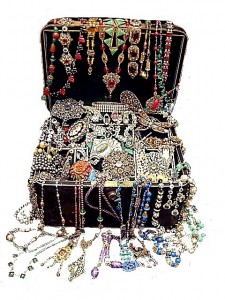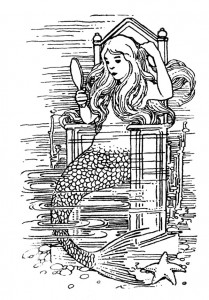A case over Rhode Island sludge disposal is finally over after 27 years [Providence Journal]
Posts Tagged ‘Rhode Island’
CPSC confirms rhinestone CPSIA ban
On July 17 the Consumer Product Safety Commission refused to exempt or stay the coverage of crystals, rhinestones and glass beads under the Consumer Product Safety Improvement Act of 2008. Although lead has long been an ingredient in the manufacture of all true crystals, most rhinestones and many glass beads, there seems to be a dearth of actual real-life instances of children contracting lead poisoning from licking, chewing or swallowing these baubles, apparently because the lead in question, unlike lead in metallic form or in paint pigments, is bound to other substances and not “biologically available”.  “Even if you have it in stomach acids for weeks it does not come out,” said Michael Gale, director of the Fashion Jewelry Trade Association, in one recent story. Gale’s trade group had petitioned (PDF) for the regulatory relief. (Earlier background in our March 7 and Feb. 25 posts).
“Even if you have it in stomach acids for weeks it does not come out,” said Michael Gale, director of the Fashion Jewelry Trade Association, in one recent story. Gale’s trade group had petitioned (PDF) for the regulatory relief. (Earlier background in our March 7 and Feb. 25 posts).
To a large extent the Commission’s hands were tied (PDF) by the absolutist, not to say fanatical, prescription of CPSIA itself, which directs that exemptions be turned down if they could lead to “any” — not “infinitesimal”, not “too small to worry about” — absorption of lead or public health risk. This point was recognized by both the commission’s career staff (PDF: “the staff would have recommended that the Commission not consider the product to be a hazardous substance to be regulated under the FHSA”) and by its three commissioners (Tenenbaum, Moore, Nord statements). CPSC Chairwoman Inez Tenenbaum, a Democrat, noted that the law “does not allow for the consideration of risk”. So it doesn’t matter that other jurisdictions, like Europe or California, may regulate this topic in a more realistic way, or that vast stocks of existing children’s clothing, from performance dance troupe outfits to 11-year-olds’ “blingwear”, will instantly be rendered worthless. It doesn’t even matter whether a kid’s health is at more risk (by way of traffic accidents) from being driven to the mall to buy a substitute garment than from going ahead and wearing the rhinestone-bedecked tiara or camisole in question (coverage: The Hill, ShopFloor, Manatt Phelps & Phillips, Rick Woldenberg, Way to Bow, Los Angeles Times).
As Commissioner Nancy Nord notes, the ban will inflict major economic losses, possibly extending to the disappearance of entire product lines, since consumers generally don’t like plastic substitutes for rhinestones as well as the real thing.  America’s costume jewelry industry is based in Rhode Island, and the Providence Journal has led with the most serious newspaper coverage (“Kids can’t wear rhinestones“) of last month’s decision, which as usual has been entirely ignored by the New York Times and various other large papers. More: Justin Katz at Rhode Island blog Anchor Rising (“So, the economy is struggling, right? Well, what better time to beginning banning products that are acknowledged to be safe and for which there’s an active market?”). For the effects of the ban on one well-known purveyor of kids’ clothes, Gymboree, see this March Washington Post report, as well as our March 23 account. Although the CPSC is making noises about concentrating its enforcement on products for kids 6 and under — a cutoff mentioned nowhere in the law — Rick Woldenberg thinks this is doomed to fail as a step toward reassuring businesses, however well-intentioned it may be, since the goods remain flatly illegal for kids 7-12.
America’s costume jewelry industry is based in Rhode Island, and the Providence Journal has led with the most serious newspaper coverage (“Kids can’t wear rhinestones“) of last month’s decision, which as usual has been entirely ignored by the New York Times and various other large papers. More: Justin Katz at Rhode Island blog Anchor Rising (“So, the economy is struggling, right? Well, what better time to beginning banning products that are acknowledged to be safe and for which there’s an active market?”). For the effects of the ban on one well-known purveyor of kids’ clothes, Gymboree, see this March Washington Post report, as well as our March 23 account. Although the CPSC is making noises about concentrating its enforcement on products for kids 6 and under — a cutoff mentioned nowhere in the law — Rick Woldenberg thinks this is doomed to fail as a step toward reassuring businesses, however well-intentioned it may be, since the goods remain flatly illegal for kids 7-12.

Hugh Hewitt (via Wood) draws a wider moral from politicians’ refusal to take responsibility for the series of disasters the law has brought about:
The refusal of Congress to move to clean up the mess it made with CPSIA also announces what will happen after Congress passes its magic wand over health care and blows up who knows what: nothing. Tough luck. Deal with it. They will all have campaigns to run which won’t want to focus on the new law’s failures and shortfalls.
At Forbes, meanwhile, Jeff Stier of the American Council on Science and Health points out that soil from the White House organic garden has higher concentrations of lead than many products banned under the new law.
PUBLIC DOMAIN IMAGES by illustrator Gordon Robinson from 1916 Samuel Gabriel & Sons reprint of Alice’s Adventures in Wonderland, courtesy ChildrensLibrary.org.
CPSIA and children’s jewelry
Metal jewelry is among the relatively few children’s products that presents a risk of lead ingestion to children not approximating zero, so it’s not especially surprising that it is treated with special stringency under the Consumer Product Safety Improvement Act. As CPSC’s guidelines explain, metal children’s jewelry becomes subject to testing and certification requirements on the 20th of this month (its makers do not benefit from the one-year stay) and items with even the tiniest dab of paint are subjected to additional requirements, including a separate testing/certification requirement that is already in effect. Since the law went into effect lead content has been limited to 600 parts per million in both jewelry and paint, and on August 14 the threshold for paint content will drop to 90 per million. Lead in its natural state has in many eras been a popular constituent of jewelry because of the metal’s soft and easily worked consistency. It is also a constituent element of all true crystal and many or most rhinestones — although there is much evidence that it is poses far less hazard to health in those forms because it tends to remain chemically bound into the crystal structure rather than leaching or dissolving out if chewed or ingested.

Given the stringency of its testing requirements and its unfriendliness toward component certification, CPSIA is not surprisingly causing serious economic difficulties in the children’s jewelry business, not excluding makers who have never used materials or components containing lead but must shoulder the extensive cost of testing anyway. HABA, the much-admired German toy company, has already announced the departure of its jewelry line from the U.S. market:
Due to the new CPSIA laws we have made the voluntary financial decision to no longer have the jewelry section in our catalog. The 2009 catalog will not include the jewelry. This does NOT mean that our current jewelry does not meet the ASTM requirements. Our overall jewelry sales are a very small percent of our business and the cost to test these items would outweigh the margins to sell the products.
Rhode Island is the historic center of costume jewelry making in America, and the Providence Business News reported recently on the plight of some of its makers. Keith Barber, partner in Rainbow Sales Inc. in Cranston,
said he has been following this issue for at least five years, since California adopted a strict law banning lead in children’s products. The California law became the model for the federal version, and Barber noted that California included an exclusion for rhinestones and crystals. California, he said, “took the time and did it right.”
Alan R. Green, owner and operator of Argo Products in Johnston, like Barber has thousands of dollars now tied up in unsalable rhinestone items, and believes that plastic substitutions will not be as broadly appealing to customers.
Green says that he could live with going out of business if he were a lousy businessman or as a result of the weak economy. “But to lose my business because of an ill-conceived federal regulation that is completely divorced from reality, that’s really going to hurt,” said Green.
The Fashion Jewelry Trade Association (FJTA), based in North Kingstown, R.I., “represents about 2,500 costume jewelry makers worldwide,” the article says. Its president, Michael Gale,
said his organization several weeks ago submitted a 37-page petition to the CPSC, formally requesting an exclusion for crystal, rhinestone and glass, complete with scientific evidence and a risk-assessment study in what he called a “very elaborate presentation.” … No response has been received yet, Gale said.
In the period leading up to CPSIA’s passage, the most publicized death — even, by some accounts, the only death — of an American child relating to an item regulated by CPSIA was that of 4-year-old Jarnell Brown of Minneapolis, who per the Star-Tribune “died from swallowing a heart-shaped charm made almost entirely of lead” in a charm bracelet that came free with Reebok sneakers bought by his mother; Reebok paid a $1 million fine. Minnesota Sen. Amy Klobuchar cited the case in campaigning for some of the law’s most stringent provisions. It can be hard to get a clear account of what happened in the Brown poisoning, and Michael Shaw has tried to track down “numerous inconsistencies in the reporting of this entire tragic business, including the health of the child before this incident, how he obtained the bracelet, and how a child with supposedly no history of ingesting foreign objects did so.”  As far as the case for CPSIA goes, it bears repeating that the federal laws already in effect made it punishable for Reebok to distribute the merchandise in question — hence the record-setting fine (as well as other consequences to that company). The main point of CPSIA was to clamp a draconian regulatory regime on products that, unlike the heart charm, weren’t a risk for poisoning anyone. More commentary on the Jarnell Brown case: Deputy Headmistress, scroll also to comments; Kathleen Fasanella, scroll to third example in her response; Valerie Jacobsen in comments at League of Ordinary Gentlemen. On the adequacy of CPSC’s legal authority to address lead in jewelry under previous law, see also Rick Woldenberg/Little Ida.
As far as the case for CPSIA goes, it bears repeating that the federal laws already in effect made it punishable for Reebok to distribute the merchandise in question — hence the record-setting fine (as well as other consequences to that company). The main point of CPSIA was to clamp a draconian regulatory regime on products that, unlike the heart charm, weren’t a risk for poisoning anyone. More commentary on the Jarnell Brown case: Deputy Headmistress, scroll also to comments; Kathleen Fasanella, scroll to third example in her response; Valerie Jacobsen in comments at League of Ordinary Gentlemen. On the adequacy of CPSC’s legal authority to address lead in jewelry under previous law, see also Rick Woldenberg/Little Ida.
Children’s jewelry is also produced by many beaders, crafters and other small enterprises for sale at local arts fairs, Etsy, and so forth.* The outcry on CPSIA from small producers, dealers and distributors includes, to pick a sampling, Fairy Tale Jewels, Angie Vinez, Birds and the Beads (“Even if the components have all been certified (such as TierraCast pewter), the CPSIA law still requires that the final product be tested regardless.”), My Aphrodite, Rings and Things, My Charmed Life, and Michon Jewelry.
In the coming days (per the article) CPSIA is expected to be a major topic of discussion at the annual exhibition of another jewelry trade group, the Providence-based (and fine-jewelry-oriented) Manufacturing Jewelers & Suppliers of America (MJSA), which holds its MJSA Expo at New York’s Javits Center from Sunday Mar. 8 through Tuesday, Mar. 10. Certain newspapers that have dismissed concerns about CPSIA’s effect on small businesses as “needless fears” could even send a reporter to that expo if they wanted — it’s only a few blocks’ stroll.
* Lab testing costs are likely to mount into the many thousands of dollars for many kitchen-table and cottage-industry makers, especially if they use many colors of bead or paint and produce multiple or customized styles.
Grains of enmity
A legal spat over who can serve rice in the food court of a Providence mall has cost the owner of a Chinese food stand $250,000 in lawyers’ fees so far. [Boston Globe]
Claim: access to cable Playboy Channel caused pain, anguish
Marc Randazza (Dec. 12; source link he cites is NSFW):
A Rhode Island family filed a lawsuit in Kent Superior Court claiming that Verizon Communications caused “great pain, anxiety, nervousness and mental anguish,” by providing access to the Playboy Channel. Plaintiffs Robert Bourne, Denise Roy and daughters Elice Roy and Danielle Bourne are seeking compensation for “current and future medical bills.”
Latest issue of Class Action Watch
The latest issue of the Federalist Society’s Class Action Watch has many articles of interest to Overlawyered readers:
- William E. Thomson & Kahn A. Scolnick on the Exxon Shipping case;
- Jimmy Cline on Arkansas’s disregard for class action certification standards;
- Jim Copland on the “Colossus” class action;
- Laurel Harbour on the New Jersey Supreme Court decision on medical monitoring class actions;
- Lyle Roberts on lead-counsel selection in securities class actions;
- Mark A. Behrens & Frank Cruz-Alvarez on the lead paint public nuisance decision by the Rhode Island Supreme Court; and
- Andrew Grossman, extensively citing to Overlawyered and my brief in discussing the Grand Theft Auto class action settlement rejection.
Station nightclub fire: government defendants settle
The state of Rhode Island and town of West Warwick, the last major defendants left in the lawsuits over the Station/Great White fire, agreed to throw $10 million apiece into the settlement pot, which now reaches $175 million, to compensate the 200 injured and survivors of the 100 killed in the 2003 blaze. The town of West Warwick, population just under 30,000, is expected to have to borrow heavily to enable its payment; it has a $4 million insurance policy, but defense litigation costs will be deducted before any of that money is made available for the settlement (RedOrbit/ProJo, more, AP/Firefighting News via Childs).
Dozens of private companies named in the suits had settled earlier, including many with peripheral or remote connections to the calamity, such as beer sponsor Anheuser-Busch, which together with a beer distributor agreed to pay $21 million, and radio operator Clear Channel, which paid $22 million. West Warwick will wind up paying much less than that, although its negligent contribution to the disaster (in failing to enforce key provisions of its own fire code) would appear immeasurably greater. Earlier posts here.
WLF on Rhode Island lead paint verdict
Attorneys Thomas R. Bender, Richard O. Faulk, and John S. Gray analyze the Rhode Island Supreme Court ruling in the lead paint case, detailing the history of the case and note the implications for other public-nuisance suits in the global warming and mortgage foreclosure fields.
Breaking: Rhode Island lead paint decision overturned
So AP reports. More details as they become available.
9:43: AP/Boston Globe reports a dramatic rejection of public-nuisance theory, holding the case should’ve been dismissed years ago. Good news that. The Rhode Island Supreme Court decision was unanimous.
5:00: Here is the opinion itself. James Beck has the most comprehensive analysis of the opinion so far; Walter gives thorough background at Point of Law as well as a roundup of other links. The defendants and NAM have released statements; Motley Rice claims they were doing it for the children, which doesn’t explain their self-serving settlement with DuPont or why they asked for a highly inefficient remediation remedy that would have maximized their attorneys’ fees.
Also: Jonathan Turley (who I just learned has a year-old blog with over a thousand posts), who, to his credit, has opposed such lawsuits; OpenMarket; Jane Genova; Publius. Attorney General Patrick Lynch is unhappy about the legal setback to his campaign contributors constituents.
Existing abatement efforts already required of landlords under Rhode Island law mean that lead paint exposure is at an all-time low in the state–evidence that was excluded at trial.
Deep pocket files: The Great White shakedown winds down
Sealed Air makes polyethylene foam for packaging material. The Great White plaintiffs allege that polyethylene foam in the soundproofing was part of the reason the Rhode Island Station nightclub fire spread so fast, killing 100–though they have no evidence that Sealed Air manufactured the foam in the club, not to mention the fact that the packing foam was never intended to be used as building material. Not to worry: with joint and several liability in Rhode Island, Sealed Air faced billions of dollars of potential liability because all of the other deep pockets (dozens of defendants ranging from a radio station to four other foam manufacturers to Anheuser-Busch to the bus that transported the band to the concert to a television station that covered the fire) have settled, Sealed Air couldn’t risk being held even 1% liable, especially given that at a trial plaintiffs would have no incentive to blame empty-chair or empty-pocket or settling defendants. Sealed Air will pay $25 million in protection money. (AP; Providence Journal; TortsProf). The miscarriage of justice continues, but the remaining defendants are apparently judgment-proof.
